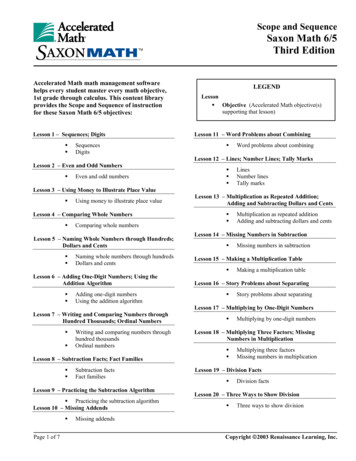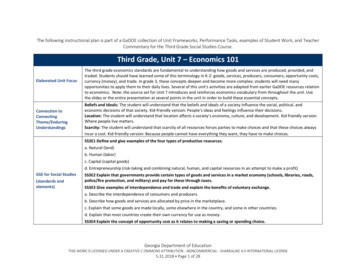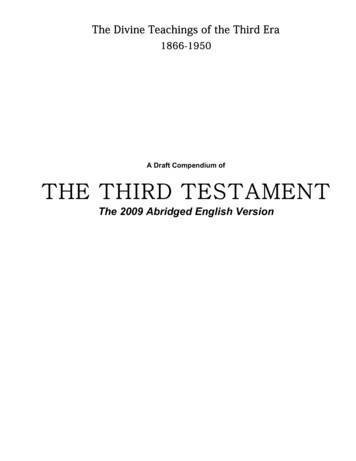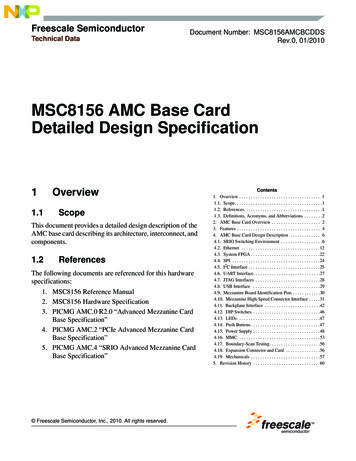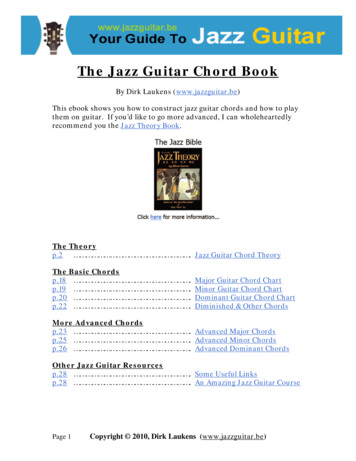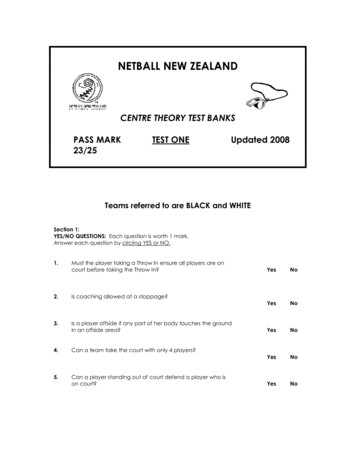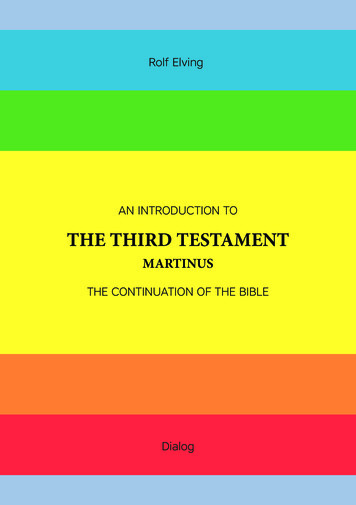
Transcription
Rolf ElvingAN INTRODUCTION TOTHE THIRD TESTAMENTMARTINUSTHE CONTINUATION OF THE BIBLEDialog
Rolf ElvingAN INTRODUCTION TOTHE THIRD TESTAMENTTHE CONTINUATION OF THE BIBLE
PublisherDialog Rolf ElvingÄrlegatan 7c414 57 Göteborg Dialog Rolf Elvinginfo@tredjetestamentet.seThis book is free to print and publish in non-commercial ways if unchanged. The cosmic symbols of Martinus as well as the quotations from TheThird Testament are copyright protected by Martinus Institut, Copenhagen,Denmark.
CONTENTFOREWORD. 9Chapter 1 PROPHECIES IN THE BIBLE ABOUT A THIRDTESTAMENTThe Old, the New and the Third Testament. 11False prophets. 11The continuation of Christ’s mission. 11I have much more to say to you. 12Jesus’ primary mission. 12The purpose of the Third Testament. 13The Eternal. 14Martinus’ initiation. 15Chapter 2 REINCARNATIONWithout reincarnation, no kingdom of God. 19Reincarnation. 20Two worlds. 21The parables of Christ. 22The first epoch of Christianity. 23Eternal punishment. 24The unintellectual epoch of Christianity. 25Chapter 3 THE ETERNAL GODHEADAn imaginary antithesis of reality. 27The body and soul of the Godhead. 28God and the sons of God. 29The Fall. 30Being separated from and united with God. 31Interaction with the spiritual world. 32Contact with the spiritual world. 33Christ and the eternal spiral cycle. 34
Cosmic Consciousness. 34The spirit of God was hovering over the waters. 35Cosmic symbols.35Father, Son and Holy Spirit. 35Symbol explanation – The trinity.38The divine something – X1. 38The creative ability of living beings – X2. 38The created – X3. 39Summary. 39Symbol explanation – The eternal Godhead and the eternal sonsof God.40The red colour – the plant kingdom. 42The orange colour – the animal kingdom. 42The true human kingdom and the spiritual worlds. 44Indigo – the kingdom of bliss. 45The spiral cycle. 46The Bible and the “face of God”. 47The Creator cannot be named. 48Chapter 4 THE WORLD SITUATION SEEN IN THE COSMICPERSPECTIVEThe prophecies.49Mankind in conflict with itself.50The Day of Judgement.51Loving one’s neighbour offers better protection than weapons.51The road away from the war.52The ability to love out of suffering.52Symbol explanation – The unfinished human kingdom.53Chapter 5 THE REALISATION OF THE KINGDOM OF GODThe cosmic view of life.56How the kingdom of God becomes a reality.57The spiritual unification of mankind.64The limitations of material science.65
The peoples and nations of the earth are dependent on each other.65Science is thought control.66After the darkness comes the light.67Reality as Love.67The Science of Love.68Symbol explanation – The perfect human kingdom of the future.69Appendix A – THE COVER SYMBOLS OF THE THIRDTESTAMENT. 72Symbol explanation.72Appendix B – WHO IS MARTINUS?. 79THE LITERATURE OF THE THIRD TESTAMENT.83ARTICLES.85INFORMATION ON THE THIRD TESTAMENT.87
THANKS!The publication of this book carries with it thoughts of gratitude to myfriend and teacher, Martinus, for the wisdom and inspiration with whichhe has enriched my life. May the light from this wisdom reach over thewhole world!I would also like to express equally warm thanks to all the friends who invarious ways supported me in the writing of this book.Rolf ElvingRolf Elving and Martinus.
FOREWORDAn extraordinary event has taken place in our time. To the Old and NewTestaments of the Bible there has been added a third! With this Third Testament the message of love that is inherent in Christianity has become rooted in everyday reality – a connection that up until now hasbeen missing. The answers to the eternal questions – the solution to themystery of life, immortali ty and the existence of God – are explainedhere logically and scientifically. The ways of God are now no longer un fathomable!The Third Testament transforms love, that is to say “loving one’s neighbour as oneself ”, into scientific fact by demonstrating that this attitude towards life is in harmony with a cosmic worldview. In this way, the messageof love in all world religions becomes firmly established as fact.The Third Testament proves that there is wisdom in doing good! Selfishness is a symptom of ignorance, “one knows not what one does.”The good person is not foolish; he is wise! In the light of the Third Testament’s cosmic worldview, Christ’s loving behaviour becomes an e xpressionof crystal clear logic and science.That Christ’s mission was not quite complete but needed to be continuedis evident from his proclamations about the future. He said to his disciples:“I have much more to say to you, more than you can now bear. But when he,the Spirit of truth, comes, he will guide you into all truth. He will not speakon his own; he will speak only what he hears, and he will tell you what is yetto come.” (John 16:12-14)Is the Third Testament really the fulfilment of this prophecy? Accordingto Martinus, the author of the Third Testament, the answer is yes, and thisis a statement that can be verified. The argumentation is to be found in thewritings that make up the Third Testament.The main, seven-volume, work of the Third Testament is called in theoriginal Danish, Livets Bog, which is also its international title, this titletranslating into English as The Book of Life. The title points to reality asthe source of all wisdom. The all-encompassing reality of existence is the9
true book of books, the Bible of Bibles. It is therefore in reference to this“book” that all theories, ideas and statements must be judged.Martinus writes, “Livets Bog should thus give the student an insight intohow this correspondence or this direct speech of life exists as the absolutelyone and only fundamental religion in existence, in that it can only exist withabsolutely everyone as teachers, everyone as pupils and everything as its doctrines. As all living beings thus exist as members of this religion alreadyat birth, it has no admission ceremonies. And as the range of its scope frometernity to eternity comprises nothing less than the universe itself, we findourselves faced with the one and only existing religion, in which there is literally to be found only ‘one flock and one shepherd”. (Livets Bog 1, 15)The Third Testament is a spiritual science. In this introduction, how ever, priority has been given to the answers, together with a summary ofthe ideas, rather than the argumentation and logical foundation on whichthey are based.10
Chapter 1PROPHECIES IN THE BIBLE ABOUTA THIRD TESTAMENTThe Old, the New and the Third TestamentOn November 24, 1981, a work was published by Borgens in Copenhagenwith the challenging title, The Third Testament. To the two testaments ofthe Bible – the Old and the New – has been added a third. The authorcon siders it to be a continuation of the Bible and that the Third Testamentis the fulfilment of Jesus’ prophecy: “But the Counsellor, the Holy Spirit,whom the Father will send in my name, will teach you all things and willremind you of everything I have said to you.” (John 14:26)(According to the Third Testament, spirit is the same as consciousness,and consciousness the same as thoughts and knowledge. The Holy Spirit isthoughts and know ledge that express the truth about God and life).False prophetsWho can possibly feel both called and chosen to write a continuation ofthe Bible? There are two alternatives: either the work is written by a falseprophet or by a true one. (See Mat. 24:11) If it is written by a false prophetthen it is nothing less than blasphemy. If it is written by a true one, well, Jesus’ prophecy has been fulfilled! If the Third Testament is a continuationof the Bible, it must be in complete harmony with Jesus’ doctrine of love.It must, moreover, answer questions that have never previously been fullyexplained.The continuation of Christ’s missionThe prophets of the Old Testament predicted the coming of the Messiah.The dispute between the scribes and Christ was about whether he was the11
AN INTRODUCTION TO THE THIRD TESTAMENTMessiah or not. Regarding the continuation of Christ’s mission, The NewTestament states that, “All this I have spoken while still with you. But theCounsellor, the Holy Spirit, whom the Father will send in my name, willteach you all things and will remind you of everything I have said to you.”(John 14:25-26)“. And I will ask the Father, and he will give you another Counsellor to bewith you forever – the Spirit of truth. The world cannot accept him, becauseit neither sees him nor knows him.” (John 14:16-17)As is evident from these quotations, Jesus was aware that his missionhad a continuation.I have much more to say to youJesus apparently could not convey all he knew to the age in which he lived.The scribes neither wanted nor were able to understand him. The disciples,for whom there was no higher wish than to understand everything that hewas telling them, were also, despite their good intentions, unable to understand. This becomes evident from the following passages, amongothers: “I have much more to say to you, more than you can now bear.”(John 16:12) “Though I have been speaking figuratively, a time is comingwhen I will no longer use this kind of language but will tell you plainly aboutmy Father.” (John 16:25)It is worth noting that these words were directed to his disciples. It wasnot possible for Jesus to make his message comprehensible, even to hispersonally chosen disciples. Not even this genius of a teacher could bridgethe gap in experience that existed at that time. Only time and evolutioncould change those conditions.In his night-time conversation with Nicodemus, a member of the HighCouncil, Jesus exclaims, “You are Israel’s teacher and do you not understandthese things?” “I have spoken to you of earthly things and you do notbelieve; how then will you believe if I speak of heavenly things?” (John 3:10)Jesus’ primary missionWhen Jesus taught, he spoke in parables, but these were difficult for eventhe chosen disciples to understand. With regard to the purely practical12
PROPHECIES IN THE BIBLE ABOUT A THIRD TESTAMENTside of his teaching, the conditions were better. Here he could freelydemonstrate the power of love, above all through the example he gave offorgiving his executioners. Nailed to the cross, he prayed, “Father, forgivethem, for they do not know what they are doing” (Luke 23:34), and in thisway he proved that he lived as he taught.On the cross he demonstrated the stage of morality that human beingshave to reach in order to become fully evolved human beings “in God’simage” (Gen.1:26). Only when everything can be forgiven has love finallywon over evil. It is clear that mankind still has a long way to go before it iscapable of living in this way. Two thousand years after the birth of Christ,the real meaning of the crucifixion is still not understood, much less livedby. A striking reminder of this is the fact that when the Pope, the highestrepresentative of the Roman Catholic Church today, visits his flock, he hasto travel in a bullet-proof glass cage.Jesus’ primary mission was to provide us with a practical example of perfect love; the intellectual explanation of the mystery of life was to belong to a later era.The purpose of the Third TestamentOne needs a personal, realistic experience of immortality, an initiationinto “the Eternal”, in order to be able to write a continuation of The Oldand New Testaments. The Bible describes these kind of experiences as theHoly Spirit. The Holy Spirit lifts the consciousness out of the material andtransient world into the causal world of eternity. In this state, the initiatefinds him or herself in the Holy of Holies. In the meeting with the EternalOne, all the mystery surrounding the real nature of life and God is dispelled.The Third Testament analyses the path to “the kingdom of heaven”. Thetime has come when the truth about life can now be revealed to the intellect, instead of being merely represented in “imagery”, as it was b efore.The Bible’s postulate of an omnipresent, omnipotent and omniscient Godwith boundless love, the statement that everything seen with the eyes ofGod is “exceedingly good”, the law that you should “love God above all andlove your neighbour as yourself ”, the understanding of “evil” and “good”,13
AN INTRODUCTION TO THE THIRD TESTAMENTthe requirement to forgive everyone and everything “seventy times seven”times a day (Mat.18:22) – all hitherto unattainable human challenges –require a world view that is able to form a synthesis of time and eternity inorder for it to be grounded in reality. The Third Testament therefore analyses the eternal wisdom for the mature seeker of truth who needsfacts, logic and evidence.The Old, New and Third Testaments treat eternal life on different levels,each adapted to its own epoch. Any work that starts where the earlier twoleave off must natural ly treat the subject from a new and higher point ofview.It is a well-recognised fact that interest in the established religions is insharp decline. The triumphal progress of material science over the worldhas led to a situation where anything that has even the faintest hint of religion is regarded as blind faith and superstition. In the Third Testament,the eternal wisdom is explained in a new form in keeping with the times.It does not stand in opposition to reason, but rather is consistent with today’s, as well as the future’s, requirements of scientific correctness. Theonly thing that can justify a Third Testament is if it were to bring the Bibleto completion and provide answers to human beings’ hitherto unansweredquestions concerning the meaning of life.It is obvious that the solution to the mystery of life is not to be foundwithin the world of our physical senses. The answer to the question, “Whoam I?” resides solely within ourselves. The solution to the mystery of liferequires intuitive or spiritual talents; it requires an experience of immortality. Only from the point of view of eternity is it possible to bring orderinto the d iversity of temporal details. In this light, it is also revealed thatthe love that Christ manifested is in contact with reality. Through an understanding of the synthesis of time and eternity, God becomes visible ineverything and everyone and we no longer speak with Him “like a poorreflection in a mirror” but “face to face.” (1 Cor.13:12)The EternalIt is understandable that the Bible, to the scientifically minded person, hasbecome a closed book. Today science deals mostly with the temporal and14
PROPHECIES IN THE BIBLE ABOUT A THIRD TESTAMENTtransient, with all that is subject to the eternal law of change, i.e. with thelaw-bound reactions of energies. In contrast to modern knowledge, thetheme of the Bible is the story of the Eternal, of the creator of everything,the one God, and of the abiding presence and necessity of love. The Biblecontains accounts of the moral laws that the Eternal One communicates,through the mouths of His prophets, to His people.Despite all the knowledge that is being taught at today’s educationalestablishments, this is not where we find the answer to the mystery of life.Regardless of whether one is a doctor or professor, regardless of what degree one has attained, no one has yet found the answer through thesemeans. There is, in fact, no academic institution that can offer “a pureheart” as a graduation certificate.If the prophets are witnesses to truth, their prophecies must be fulfilledand the Kingdom of God must become reality. Every reasonable doubtabout Christ’s practical example being in agreement with reality must beremoved if the wisdom contained in Christ’s Sermon on the Mount is to beput into practice. If it is not, the doctrine of love remains an unrealisabledream.It is this, not entirely easy, problem that the Third Testament mustsolve. Man has placed God before the court of reason. Up till now, He hasbeen convicted without a competent counsel for the defence. Now, how ever, the time has come when His personal spokesman or counsellor isentering into the debate.Martinus’ initiationMartinus describes the spiritual process that made him conscious of immortality, which was what enabled him to write the Third Testament, inthe following way: “The ‘spirit of God’ that ‘moved upon the face of the waters’, the ‘fire’ that ‘burned in the thorn bush’ before Moses, the ‘fire’ thatmade Elijah ascend into heaven, the ‘fire’ that ‘transfigured’ Jesus on themountain, the ‘fire’ that appeared above the heads of the disciples and subsequently turned Saul into Paul on the road to Damascus, the ‘fire’ thatthroughout all times has been the ‘alpha’ and ‘omega’ in every form of thehighest creation, manifestation or revelation, was blazing here before my15
AN INTRODUCTION TO THE THIRD TESTAMENTown eyes, vibrating in my own breast, in my own heart, enveloping my entirebeing It was as if I rested at the bosom of the almighty Godhead. I dwelledat the source of universal love; I saw divine perfection; I saw that I was onewith the Way, the Truth and the Life, and that I was one with the greatFather.” (On the Birth of my Mission, Chap. 17)“For a more detailed account of revelation, the Holy Spirit or initiation Imust refer the reader to my work, Livets Bog. Here I will merely mention thatsuch a sublime event is always a personal experience, intended solely for thebeing in whom it takes place, and it can of course never be directly experienced as fact by any other being than the one that it overshadows. The spiritual visions I have had would thus mean nothing in themselves if they had not left behind effects that were visible and accessible to myfaculties of perception. What is fundamental for the readers is thus not the spiritual experiences I have had, but the effects they have created, since these can to someextent be investigated by every human being who is impartial, liberated andwho has an appropriate standard of morality. These effects constitute thesum total of my manifestation, that is, the creation of a true, mathematicalanalysis of the world, an absolutely unshakeable spiritual science and theinitial stages of the emergence of a new mentality or culture resting on it, inwhich a true understanding of life, with its finely drawn laws of love andculminating world logic and highest answer that “Everything is very good”,far from being utopianism, is transformed into real life, into tangible factsaccessible to every human being that is sufficiently developed or mature inreasoning and feeling.” (Martinus: On the Birth of my Mission, Chap. 19-20)The passage that follows was written by Martinus in his twilight years,when he had completed his collected works and the only thing remainingto be done was to present them to the public with their correct title: TheThird Testament.“What is ‘the Counsellor, the Holy Spirit’? – It is certainly not a person ora new Christ who will come to mediate between the Godhead and humanbeings It is a science of the universe and consequently of God. It must be a16
PROPHECIES IN THE BIBLE ABOUT A THIRD TESTAMENTrecord of the solution to the mystery of the universe. It is thus a ‘book’ thatpeople can read just as they can read the Bible.This ‘Counsellor, the Holy Spirit, whom the Father will send in my name’that Christ predicted is thus a ‘book of life’ or a ‘book of knowledge’ that willbe made manifest to mankind.But a real book of truth that deals with the Godhead and the universecan be nothing other than the continuation of the cosmic world culture thatChrist initiated almost two thousand years ago and that we know under theterm ‘Christianity’. It has to be a book that can create intellectual, not dogmatic, schools and colleges of Christianity. It must be a book that reveals thefinished, perfected Christian world culture in a physical as well as a spiritualmani festation. It must be a book that shines a light through the culminationof both darkness and light and the vital function in the universe that is aresult of this: the immortality of living beings.It must be a book that presents infinity and eternity and the resultantliving, vital functions in the form of time and space, which on analysis can bereduced to ‘omniscience’ and ‘omnipotence’, and which when in perfectco-operation constitute ‘universal love’ and are thereby the same as thatwhich is eternally alive in living beings. This brings us to the ‘fixed point’ ofthe universe and its source, the ‘Father of Life’, the absolutely one and onlyall-pervading, radiant and eternal Godhead.Such a book cannot avoid containing the ‘much more’ that Christ couldhave told mankind but that God wanted to give future generations at a laterdate. Such a book cannot avoid being ‘the Counsellor, the Holy Spirit’. Owingto the fact that it fundamentally substantiates Christianity and is therebyrelated to the two testaments of the Bible, it can quite justifiably be called‘The Third Testament’.This Third Testament is consequently a book of wisdom or a book of know ledge. It reveals to us the eternal radiance of universal love. It points towardsthe ‘image of God’, and all living physical beings are, through reincarnationor rebirth, in the process of being made in this image. In the Third Testamentall unfinished beings, that is to say ‘physical beings’, animals as well as17
AN INTRODUCTION TO THE THIRD TESTAMENT umans, are seen to be on the same path, a path that leads inevitably tohcosmic consciousness and thereby to the experience of the golden radiance ofthe universe, the golden light, to what is eternally alive in living beings and,as a consequence, to an experience of ‘Christ consciousness’ and being ‘onewith God’. Christ was the model for the creation of God’s consciousness inman. Did not Christ say, ‘All authority in heaven and on earth has beengiven to me’? (Mat. 28:18) How could he be ‘in the image of God’ without thiscapacity? And how could any other being be created in this likeness withoutthat necessarily leading to the same capacity?‘The Counsellor, the Holy Spirit’ is thus, in the form of the Third Testament, a continuation of the teachings of Christ. It is a continuation ofthe message of the eternal light from ‘the star of Bethlehem’. In this ever lasting light the solution to the greatest principles of life are revealed to theworld, thereby revealing Christianity as the unshakeable, vital foundation ofhappiness and bliss as well as the basis of the existence of the universe.”(Martinus: Intellectualised Christianity)18
Chapter 2REINCARNATIONWithout reincarnation, no kingdom of GodNicodemus, who came to Jesus in the night, did not want to be seen. TheHigh Council, of which he was a member, was striving to rid themselvesof this challenger to their religious authority. But despite everything, Nicodemus could not deny that he was impressed by Jesus’ wisdom andthe power and authority with which he spoke.He said, “Rabbi, we know you are a teacher who has come from God. Forno one could perform the miraculous signs you are doing if God were notwith him.” In reply Jesus declared, “I tell you the truth, unless a man is bornagain, he cannot see the kingdom of God.”“How can a man be born when he is old?” Nicodemus asked. “Surely hecannot enter a second time into his mother’s womb to be born.”Jesus answered, “I tell you the truth, unless a man is born of water andthe Spirit, he cannot enter the kingdom of God. Flesh gives birth to flesh, butthe Spirit gives birth to spirit. You should not be surprised at my saying, ‘Youmust be born again.’ The wind blows wherever it pleases. You hear its sound,but you cannot tell where it comes from or where it is going. So it is witheveryone born of the Spirit.” (John 3:2-8)What is the meaning behind Christ’s words that we must be born “ofwater and the Spirit” in order to enter the kingdom of God? According tothe Third Testament, to be born of water means to be reborn in a newphysical organism, as water symbolises physical matter.To be born of Spirit means to grow mentally through experience. Experience is added to experience and in the process, both feeling andintelligence develop. Ultimately, the wisdom which allows us to see thekingdom of God arises. But that an old man can once again enter his19
AN INTRODUCTION TO THE THIRD TESTAMENTmother’s womb and be reborn was quite beyond Nicodemus.The Third Testament maintains that we return in one organism afteranother. Consciousness grows out of its different organisms just as childrengrow out of their clothes. The visible effects of the gradual development ofconsciousness can be seen in evolution, in the plant kingdom’s transitionto the animal kingdom and in the animal kingdom’s further developmenttowards the current terrestrial human stage.In pace with evolution, the organisms are adapted so that they fit thementality. It is because of this continuous development that man no longerhas an ape’s organism. In order to enter into the kingdom of God, it was,according to Jesus, necessary to be born many times in order for consciousness thereby to develop and mature. (Livets Bog 3, 732-742 andLivets Bog 6, 1965-1970)ReincarnationChrist saw Elijah and John the Baptist as the same person, as is shown bythe following words: “And if you are willing to accept it, he is the Elijah whowas to come. He who has ears, let him hear.” (Mat.11:14-15)Christ’s pronouncement about the law of fate – that we reap what wesow – cannot be true if we have only one physical life on earth.The requirement for being able to create a good destiny is that it isregulated by law. Why should doing good deeds be of any importance ifevil deeds as well as good ones should lead to a happy destiny? If the innocent are punished and the guilty rewarded, then justice does not exist.If we reap what we sow, our present life c
A THIRD TESTAMENT The Old, the New and the Third Testament On November 24, 1981, a work was published by Borgens in Copenhagen with the challenging title, The Third Testament. To the two testaments of the Bible – the Old and the New – has been added a third. The author considers it to be




